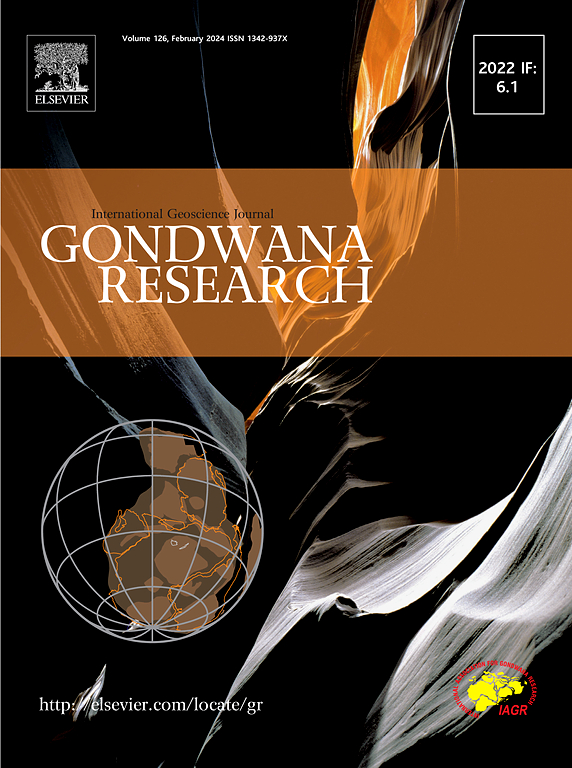Differential magmatism and tectonic evolution during the rift stage within the Baiyun Sag of the Pearl River Mouth Basin in the northern South China Sea
IF 7.2
1区 地球科学
Q1 GEOSCIENCES, MULTIDISCIPLINARY
引用次数: 0
Abstract
To investigate the magma-related formation mechanisms and structural evolution of sags within a passive continental margin setting/configuration, we selected the Baiyun Sag in the Pearl River Mouth Basin (PRMB) and identified its spatiotemporal magmatic distribution during the rift stage based on high-precision 3D seismic data, drilling data, and geochemical data. Totally three stages of syn-rift magmatism were revealed. Strong and continuous crustal extension and thinning, crustal extension and thinning with simultaneous magmatic activity, and intermittent crustal extension and thinning were suggested to be the development mechanisms of the main Baiyun Sub-Sag (M-BSS), eastern Baiyun Sub-Sag (E-BSS), and western Baiyun Sub-Sag (W-BSS), respectively. Complex multi-stage magmatism is the direct cause of the formation of high-angle sag-controlled faults with low-angle detachment characteristics in the Baiyun Sag. In addition, we explored the genesis of the multi-episodic magmatism, dynamic mechanisms, and differential evolution of fault basin structures in the Baiyun sag, which are essentially related to the reactivation of Mesozoic pre-existing faults, the differential extension-induced flow of the Cenozoic lithosphere material, and the along-fault magmatic material upwelling. This study not only serves as a significant guidance for oil and gas exploration in the Eocene strata of the northern SCS, but also provides insightful ideas for analyzing magmatic and tectonic activity in other petroliferous basins with a similar setting.

南海北部珠江口盆地白云凹陷裂谷期差异岩浆作用与构造演化
为探讨被动大陆边缘构造背景下凹陷的岩浆成因机制和构造演化,以珠江口盆地白云凹陷为研究对象,基于高精度三维地震资料、钻井资料和地球化学资料,对其裂谷期岩浆时空分布进行了识别。共揭示了同裂谷岩浆活动的三个阶段。强烈而持续的地壳伸展减薄、岩浆活动同时发生的地壳伸展减薄、间断性的地壳伸展减薄分别是白云凹陷主(M-BSS)、白云凹陷东部(E-BSS)和白云凹陷西部(W-BSS)的发育机制。复杂的多期岩浆作用是白云凹陷形成具有低角滑脱特征的高角凹陷控制断裂的直接原因。此外,探讨了白云凹陷多期岩浆活动的成因、动力机制和断陷盆地构造的差异演化,其本质与中生代既有断层的活化、新生代岩石圈物质的差异伸展流动和沿断层的岩浆物质上涌有关。该研究不仅对南海北部始新世油气勘探具有重要指导意义,也为分析其他类似背景下含油气盆地的岩浆和构造活动提供了重要思路。
本文章由计算机程序翻译,如有差异,请以英文原文为准。
求助全文
约1分钟内获得全文
求助全文
来源期刊

Gondwana Research
地学-地球科学综合
CiteScore
12.90
自引率
6.60%
发文量
298
审稿时长
65 days
期刊介绍:
Gondwana Research (GR) is an International Journal aimed to promote high quality research publications on all topics related to solid Earth, particularly with reference to the origin and evolution of continents, continental assemblies and their resources. GR is an "all earth science" journal with no restrictions on geological time, terrane or theme and covers a wide spectrum of topics in geosciences such as geology, geomorphology, palaeontology, structure, petrology, geochemistry, stable isotopes, geochronology, economic geology, exploration geology, engineering geology, geophysics, and environmental geology among other themes, and provides an appropriate forum to integrate studies from different disciplines and different terrains. In addition to regular articles and thematic issues, the journal invites high profile state-of-the-art reviews on thrust area topics for its column, ''GR FOCUS''. Focus articles include short biographies and photographs of the authors. Short articles (within ten printed pages) for rapid publication reporting important discoveries or innovative models of global interest will be considered under the category ''GR LETTERS''.
 求助内容:
求助内容: 应助结果提醒方式:
应助结果提醒方式:


